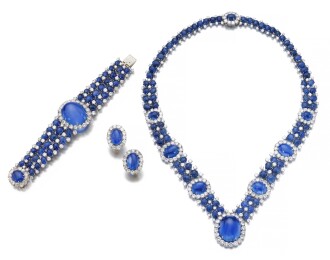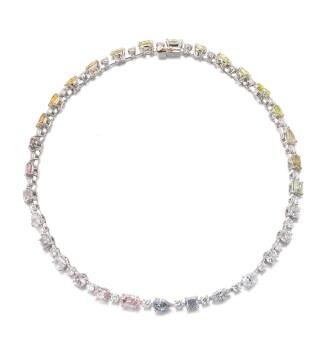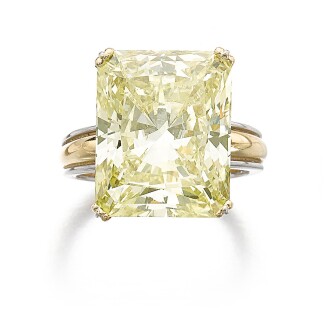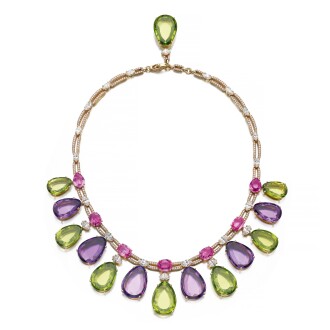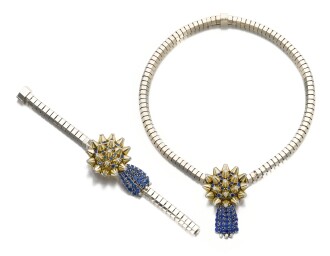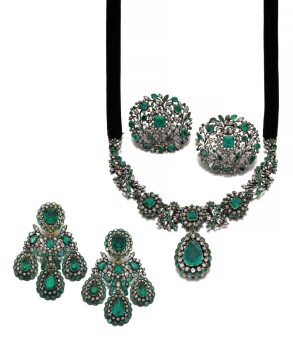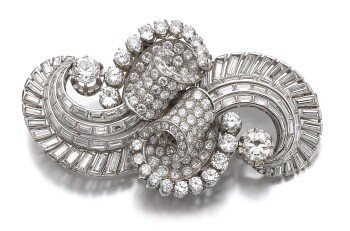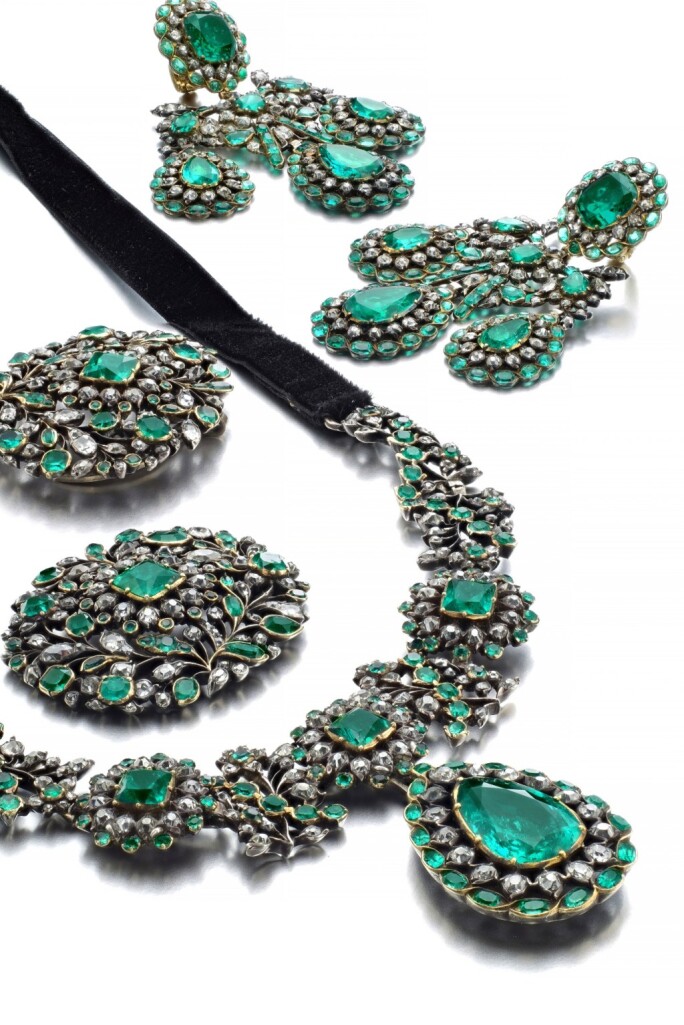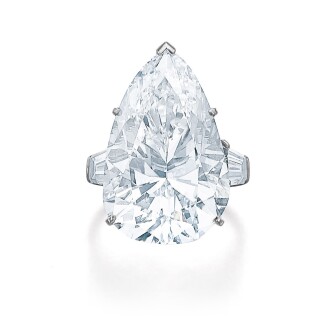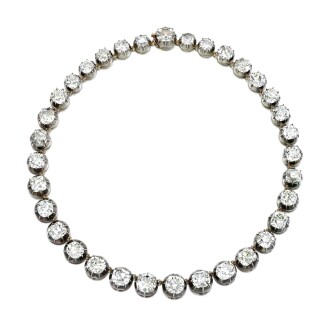T his November the Magnificent Jewels and Noble Jewels sale presents iconic designs from the world’s most prestigious jewellery houses, such as Van Cleef & Arpels and Cartier among others. The sale also features beautiful coloured diamonds, exceptional coloured stones and magnificent jewels from the early 19th century to the present day.
Maison Mauboussin
Maison Mauboussin was founded in 1827 by M. Rocher, in the midst of French political instability and colonial conquests. Despite the political distress, the period saw a rise in universal exhibitions designed to share knowledge and achievements, which eventually served as an inspiration for jewellers. In 1878, Jean-Baptist Noury, the successor of M. Rocher, received a medal in recognition of his work in the Exposition Universelle de Paris which established the Maison’s solid reputation.
Under the lead of George Mauboussin, the interwar period is characterised by exotism, reflected in the selection and quality of Mauboussin gems: jade from the Orient, pearls and coral from the Middle East... This exotism made way for the Art Deco style, in which Mauboussin ranked first in the creation of Art Deco jewellery.
In 1928, Mauboussin saw its creations reach every corner of the world by establishing branches in New York, London, Rio de Janeiro and Buenos Aires. Mauboussin’s success attracted important customers such as the Maharaja of Indore and Queen Nazli of Egypt. The gems used for this clientele are believed to be amongst the most beautiful in the world.
Throughout the years, up until today, Maison Mauboussin has reflected the evolution of women’s fashion and has managed to combine tradition with modernity in its creations.
- 1770s
- 1880s
- 1900s
- 1910s
- 1920s
- 1930s
- 1940s
- 1950s
- 1960s
- 1970s
-
MAGNIFICENT EMERALD AND DIAMOND PARURE, CIRCA 1770Estimate: 642,000 - 920,000 CHF
This parure was given by Manuel de Guirior y Portal, First Marquis de Guirior to his wife Maria Ventura de Guirior, and was then given to his great-nephew, Don José Maria de Guirior and Larrea, Marquis de Guirior, who gave it to his son Don José Fausto de Guirior and Larrea, Marquis de Guirior, who gave it to his gran-daughter, Maria delos Dolores Porcel y Guirior, Marquesa de San Millan y de Villa Alegre.
View Lot -
RUBY AND DIAMOND NECKLACE, CIRCA 1880Estimate: 180,000 - 280,000 CHF
Of garland design, set with circular-cut, cushion- and pear-shaped rubies and similarly cut and rose diamonds, one diamond deficient, inner circumference approximately 380mm.
View Lot -
CHAUMET | FINE RUBY AND DIAMOND NECKLACE, CIRCA 1905Estimate: 220,000 - 260,000 CHF
Composed of sixteen graduated clusters spaced by trefoil motifs, set with cushion-shaped rubies weighing from 0.68 to 4.37 carats, and circular-cut and cushion-shaped diamonds, length approximately 420mm, unsigned, French assay marks and maker's mark for Chaumet.
View Lot -
BOUCHERON | DELICATE DIAMOND BANDEAU, CIRCA 1910Estimate: 92,000 - 135,000 CHF
Of foliate design, decorated with circular-cut and rose diamonds, inner circumference 510mm, signed Boucheron, case stamped Boucheron.
View Lot -
SAPPHIRE AND DIAMOND BRACELET, 1920SEstimate: 20,000 - 30,000 CHF
Millegrain-set with circular-cut sapphires highlighted with similarly-, single-cut and rose diamonds, length approximately 180mm, French assay mark.
View Lot -
CARTIER | SAPPHIRE AND DIAMOND CLIP, 1933Estimate: 80,000 - 120,000 CHF
FORMERLY IN THE COLLECTION OF QUEEN VICTORIA EUGENIE OF SPAIN
Set with a cabochon sapphire stated to weigh 25.20 carats, enhanced with circular-cut, baguette, bullet- and kite-shaped diamonds, signed Cartier, numbered, French assay mark for platinum and maker's mark.
View Lot -
RENÉ BOIVIN | PAIR OF GOLD AND DIAMOND EAR CLIPS, 1940SEstimate: 40,000 - 60,000 CHF
Each designed as a cone set with rose diamonds, highlighted with beads set with circular-cut diamonds en tremblant, unsigned, French assay mark for gold.
View Lot -
 DIAMOND DOUBLE-CLIP BROOCH, 1950SEstimate: 20,000 - 30,000
DIAMOND DOUBLE-CLIP BROOCH, 1950SEstimate: 20,000 - 30,000
Of swirl design, set with brilliant-cut and baguette diamonds, detachable brooch fitting, numbered.
View Lot -
CORAL AND DIAMOND DEMI-PARURE, BULGARI AND A RING, 1960SEstimate: 20,000 - 30,000 CHF
Comprising: a brooch set with a cabochon coral highlighted with brilliant-cut diamonds, a pair of ear clips similarly set, signed Bulgari, Italian assay mark for gold, case stamped Bulgari, together with a ring, size 54.
View Lot -
BULGARI | ENAMEL AND RUBY BRACELET-WATCH, 'SERPENTI', CIRCA 1970Designed as a coiled serpent, applied with black, red and white enamel, the eyes set with pear-shaped rubies, the mouth opening to reveal a circular dial, dial signed Jeager-Le Coultre, bracelet expandable, signed Bulgari.
View Lot

Yvelines (Courtesy of Antoine Porgès)
Jules Porgès was born in Vienna and raised in Prague, where his father was a jeweller. He moved to Paris in the 1860s with his wife Anna, and became a diamond trader. He recognised the significance of the diamond finds in South Africa, and in 1873 and he sent two of his employees, Alfred Beit and Julius Wernher, down to the area. Between 1875 and 1880, he acquired several mines in South Africa: De Beers, Bultfontein, Dutoitspan and the whole of Kimberley, in association with Cecil Rhodes. He founded the Compagnie française de diamants du cap de Bonne-Espérance, which he sold to De Beers in 1887. Called ‘The Diamond King’, he also bought gold mines between 1880 and 1888 in the region of Johannesburg.

(Courtesy of Antoine Porgès)
He stopped these activities in the early 1890s and then focused then on his Parisian life. In 1892, he built a hôtel particulier on 14-18 Avenue Montaigne in Paris, where once stood the maison Pompéienne of Prince Napoléon-Jérôme Bonaparte. He also bought the château de Rochefort-en-Yvelines from the la Rochefoucauld family and asked the architect of the Ritz Hotel in Paris, Charles Mewès, to build a sumptuous château inspired by the Hotel de Salm in Paris (the Legion d’Honneur Palace). Jules Porgès was amongst the more prominent art collectors in Paris. His home housed important Old Masters, such as Rubens, Van Dyck, Rembrandt, Bruegel de Velours and Le Lorrain. It was also the place of somptuous balls and dinners. André de Fouquières in Cinquante ans de panache and Mon Paris et ses Parisiens, mentions these grand events.

Estimate: 367,000 - 460,000 CHF
View Lot
The Timeless Appeal of Art Deco Jewels
The First World War put a dramatic end to the frivolous, light-hearted spirit of the Belle Epoque and to its extravagant excesses in the fields of dress, fashion and jewellery.
Cartier, always perceptive to changes in fashion, was able to foresee well before political events dramatically changed the world during four years of conflict, that women were ready to revolutionise the way they dressed, adorned themselves and behaved in society.
During the first decade of the 20th century, Cartier had already started to trace the lines of the jewellery style which would favor the dynamic and emancipated women of the 1920s and suit their short tunic dresses and hairstyles à la garçonne. This change was triggered by the contemporary experiences of Cubist painters and certainly influenced by the Vienna Secessionist artists such as Klimt, Hoffmann and Olbrich, who promoted the evolution of the style for painting, architecture and interior decoration based on squares and circles.
Jewels gradually lost their original delicate lightness to assume a solid rigidity, foreshadowing the development in jewellery design which, after the war, would fully embrace the tenets of what is known as Art Deco.
Manuel de Guirior y Portal, first Marquis de Guirior, Lieutenant General of the Royal Navy, Viceroy of New Granada and Peru, was born in Aoiz in the old kingdom of Navarra, on March 21, 1708. Born into an illustrious Navarrese family, his parents were Don Carlos de Guirior Erdozain, and María Josefa del Portal.
Having entered the navy at the age of twenty-five, Manuel de Guirior sailed around the world serving several missions to transport troops to various locations in the Mediterranean and fought in the Seven Years’ War against the English. He soon rose through the ranks and was promoted to lieutenant in August 1738.
After decades of loyal service, Manuel de Guirior was notably appointed Viceroy in 1772, as Governor and Captain-General of the New Kingdom of Granada. In this position, de Guirior succeeded Don Pedro Mesia de la Cerda who had submitted his resignation, after been unable to control the riots in Quito, with whom he had continuous friction.
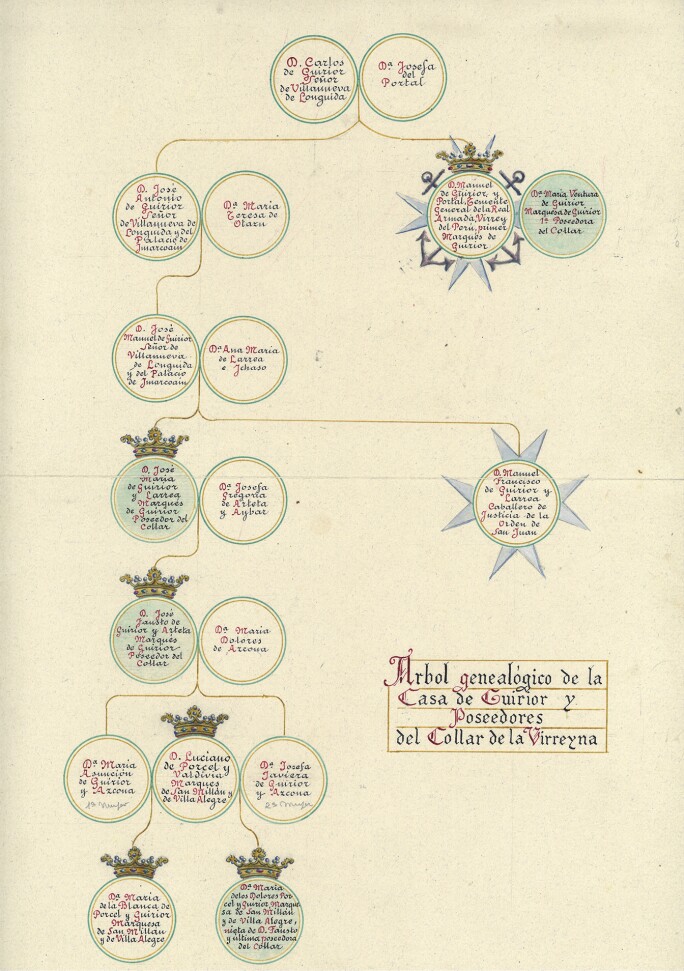
De Guirior’s appointment marked the beginning of a new era for New Granada. As Viceroy, Manuel De Guirior managed to appease the different rebel groups with peaceful interventions. He reformed the religious communities and missions and ensured a more humanitarian treatment of the native population. For example, he took steps to strengthen the economy and also carefully promoted the sciences, by founding the first public library, which aimed at the education of the indigenous population. He also reestablished the Public University, which was considered a huge success. He opened a hospital and a hospice and founded the first library in Bogota. Simultaneously, de Guirior improved the colony’s coastal defenses and altered the cultural geography of New Granada by dividing the city of Bogotá into borrios.
Following these accomplishments, de Guirior became lieutenant-general, by Royal Order, on 20th December 1774. He remained in this position until August 24, 1775, when he was appointed Viceroy, Governor and Captain-General of the kingdom of Peru, relocating to Lima in 1776.
Having later returned to Madrid, de Guirior died at the age of 80 on 25th November 1788. This parure is a rare and very fine example of late 18th Century jewellery that is still in its original form. Antique jewels rarely survived and were often dismantled. Due to their scarcity and high value, gold and silver were melted down and reused and precious gemstones were dismantled and reset in new mounts following the changes in taste and fashion.
Very few jewels in closed-back settings, where the backs of the stones are not visible, a technique used until the end of the 18th Century, still exist today, especially in the shape of girandole earrings design. Composed of a larger stone combined with a bow supporting three pear-shaped drops, this design was a favorite motif of the 17th Century and early 18th Century. The very fine emeralds in this parure further confirm its Spanish provenance.
With the discovery and development of new maritime routes in the late 15th Century, the Spanish empire had direct access to a vast amount of natural resources. It is undeniable that Manuel de Guirior, as Viceroy, was able to source the finest emeralds from Colombia.
Gifted by Manuel de Guirior y Portal, the Viceroy of New Granada and later Peru, to his wife, Dona Maria Ventura de Guirior y Otazu, this exquisite parure is referred to as the Virreina Suite in the family archives.
Explore More Antique Jewels
Of Noble Provenance
Highlighting this November’s offering of exquisite jewels of noble provenance is a beautifully matched pair of natural pearls, set in a glittering pair of diamond earrings attributed to Cartier, come from the collection of Sarah Baillie-Hamilton, born Sarah Cook (1903-1995).

Born in Montreal in 1903, she met George, the 12th Earl of Haddington when he was working as an aide-decamp to the Governer-General of Canada. The couple married in 1923, settling down in Scotland at the family seat at Mellerstain. Lady Haddington opened the family home as an emergency military hospital during the war, and was fondly remembered by the injured soldiers who recovered there for the kindness she showed to them. Her dedication to the injured troops carried into the post-war years, and she tirelessly raised funds for the Scottish National Institution for the War Blinded at Lindburn.
In addition to her many contributions during the war, Lady Haddington was also a very talented gardener, as evidenced by the gardens she created at Tyninghame House, near Haddington in East Lothian, and a classically-trained pianist. Her love and natural gift for music (her tastes ranged from Chopin to Rod Stewart) drew her into managing the first Edinburgh International Festival in 1947, which she helped guide for 14 years.
Discover More Noble Jewels





